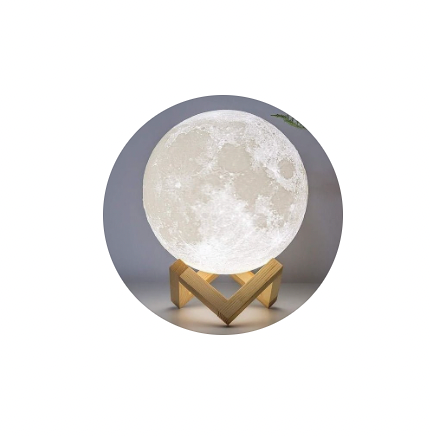How to Fix a Moon Lamp That’s Not Working? A Comprehensive Guide
How do I fix a moon lamp that isn’t working? Start by checking the power source—test the USB cable, adapter, and power outlet. If the moon lamp still doesn’t work, inspect the charging port and LED light for faults. Minor physical damage like cracks can be repaired with glue, but severe internal issues may require replacing the LED or seeking help from a qualified technician. Always charge safely and keep the lamp clean to avoid future problems.
When your moon lamp stops working, it disrupts the serene ambiance it's known for creating. This guide helps troubleshoot and fix common issues, ensuring your moon lamp illuminates once again.
Identifying the Problem
Before diving into repairs, it’s crucial to identify what’s wrong with your moon lamp. Issues can range from power supply problems to internal component failures or even physical damage. Pinpointing the problem is the first step to getting your moon lamp back in action.
Power Source Issues
Power source issues are common culprits when a moon lamp fails to light up. A faulty power supply can prevent the lamp from receiving the necessary energy to function. Checking the power source is a simple yet effective starting point in troubleshooting.
Checking the USB Cable and Adapter
The USB cable and adapter are essential for powering your moon lamp. A damaged or malfunctioning cable can interrupt the power supply. Inspecting for visible wear or damage and ensuring a secure connection can often resolve power issues.
Troubleshooting the Power Outlet
Occasionally, the problem may lie with the power outlet itself. Testing the outlet by plugging in another device can determine if the issue is with the outlet or the moon lamp's power supply. This helps narrow down the potential causes of malfunction.
Internal Component Failures
Internal components, such as the LED light or charging port, can fail and lead to a non-functioning moon lamp. Diagnosing these issues requires a closer look at the internal workings of the lamp.
Inspecting the LED Light
The LED light is the heart of your moon lamp. A faulty LED can result in a complete lack of light. Visually inspecting the LED for signs of damage or wear can reveal if it's the source of the problem.
Examining the Charging Port
A damaged charging port can prevent your moon lamp from charging, rendering it inoperable. Careful examination of the port for debris, damage, or loose connections can identify issues affecting the lamp's ability to charge.
Physical Damage Assessment
Physical damage, such as cracks or incorrect assembly, can also cause your moon lamp to stop working. A thorough physical inspection can uncover any such issues, guiding the next steps in the repair process.
Checking for Visible Cracks or Damage
Visible cracks or damage to the moon lamp can affect its functionality. Identifying any external signs of damage is crucial for understanding the extent of repairs needed to restore the lamp to working condition.
Ensuring the Lamp is Assembled Correctly
Improper assembly can lead to a non-functioning moon lamp. Ensuring that all parts of the lamp are correctly assembled and securely fastened can often resolve issues without the need for further repairs.
Step-by-Step Solutions
After identifying the problem with your moon lamp, following step-by-step solutions can effectively address the issue. Whether it's a power source problem, internal component failure, or physical damage, targeted actions can bring your moon lamp back to life.
Addressing Power Source Problems
Resolving power source problems is crucial for getting your moon lamp working again. This involves checking and repairing components like the USB cable and the power outlet to ensure a stable power supply.
Replacing or Repairing the USB Cable
If the USB cable is found to be faulty, replacing or repairing it can restore the moon lamp's power supply. Using a compatible, high-quality USB cable ensures a reliable connection and efficient charging.
Testing Different Power Outlets
When troubleshooting the power outlet doesn’t yield results, testing different outlets can help. Finding a functioning outlet ensures that your moon lamp receives the power it needs to operate.
Fixing Internal Component Issues
When a moon lamp stops working, internal component problems are often to blame. Identifying and resolving these issues can restore the lamp's functionality. This involves examining the lamp's inner workings, including the LED light and the charging port, which are critical for operation.
Replacing the LED Light
If the moon lamp's LED light has failed, replacing it is the first step toward repair. The LED is essential for illuminating the lamp and creating the desired ambience. Users need to ensure they choose the correct type of LED light compatible with their moon lamp model.
Repairing or Replacing the Charging Port
Problems with the charging port can prevent the moon lamp from receiving power. Repairing or replacing the port is crucial for restoring power supply to the lamp. It's important to handle the delicate components with care to avoid further damage.
Resolving Physical Damage
Physical damage to a moon lamp can affect its appearance and functionality. Minor cracks and damages can often be repaired, but significant damage may require more extensive fixes.
Applying Super Glue to Minor Cracks
For small cracks, carefully applying super glue can be an effective solution. This method can seal the cracks and prevent them from spreading, thereby prolonging the lamp's life. However, it's important to apply the glue precisely to avoid affecting the lamp's aesthetics.
Consulting with a Professional for Major Damage
Major damage to a moon lamp often requires the expertise of a professional. They have the necessary tools and skills to repair or advise on the best course of action, whether it's a repair or a replacement.
Preventive Measures for Future
Taking preventive measures can significantly prolong the life of a moon lamp. Proper handling, regular maintenance, and cautious charging are key to avoiding future problems and ensuring the lamp remains a captivating decor piece.
Proper Handling and Care
Proper handling and care are crucial for the longevity of a moon lamp. By avoiding rough handling and exposure to extreme conditions, users can prevent damage and maintain the lamp's functionality and beauty.
Tips for Safely Charging Your Moon Lamp
To ensure safe charging, always use the correct power supply and cable provided with the moon lamp. Avoid overcharging and keep the lamp away from water or damp environments to prevent electrical issues.
Recommendations for Avoiding Physical Damage
Placing the moon lamp in a safe, stable location where it's less likely to be knocked over or hit can prevent physical damage. Using protective covers or placing the lamp on soft surfaces can also help cushion any potential impacts.
Regular Maintenance Checks
Regularly inspecting the moon lamp can help identify and mitigate issues before they escalate. This includes checking for any signs of wear and tear, ensuring the charging port is intact, and the LED light functions correctly.
Inspecting the Lamp Periodically
Periodic inspections allow for the early detection of potential problems. Looking for cracks, checking the power supply's integrity, and testing the lamp's functionality are all part of a thorough maintenance routine.
Keeping the Lamp Clean
Keeping the moon lamp clean from dust and debris not only maintains its aesthetic appeal but also prevents potential damage. Gentle cleaning with a soft, dry cloth is recommended to avoid scratching the surface.
When to Seek Professional Help
There comes a point when professional help may be necessary to repair a moon lamp. Recognizing when DIY fixes are insufficient and consulting with a qualified technician can save time and ensure the lamp is properly repaired.
Identifying Irreparable Damage
Some damages are beyond simple repairs and may signal the need for professional intervention. Signs of irreparable damage include extensive physical damage, non-functional LED lights after attempted replacements, and issues with the power supply that persist despite troubleshooting efforts.
Signs That Your Moon Lamp Needs a Professional’s Touch
Some moon lamps may show clear signs that only a professional can address. If the lamp fails to turn on despite trying all troubleshooting tips like checking the power source or ensuring it's charged, it's a significant sign. Another indicator is unusual flickering or dimming that persists even after attempting to fix it. If the charging port seems loose or damaged beyond simple DIY repairs, this is also a moment to call in an expert. Lastly, if you've checked "How to Turn On a Moon Lamp" and "Is My Moon Lamp Legit?" and still encounter issues, professional help is needed.
Finding a Qualified Technician
Locating a technician skilled in repairing moon lamps requires attention to detail. Start by searching for electronic repair shops with good reviews and a track record of fixing decorative lamps or similar technology. It's beneficial to inquire directly if they have experience with moon lamps specifically. Recommendations from friends or online communities dedicated to moon lamp enthusiasts can also guide you to the right professional. Ensure the technician understands the intricacies of these lamps to avoid further damage.
How to Choose the Right Expert for Your Moon Lamp
Choosing the right expert for repairing your moon lamp involves several critical considerations. Firstly, verify their experience with moon lamps or similar decorative lighting. Ask for before-and-after photos of their work or seek out customer reviews to gauge their expertise. Secondly, ensure they provide a clear explanation of the potential repairs needed and the associated cost. Transparency about the repair process and fees is crucial. Lastly, a reliable expert should offer a warranty on their work, providing peace of mind that your lamp is in capable hands.
Final Thoughts on Restoring Your Moonlight Ambience
Restoring your moon lamp to its former glory not only brings back the soothing lunar glow to your space but also rekindles the unique charm that a photo moon lamp adds. Whether it's showcasing a personalized photo, highlighting a delicate photo leaf carving, or simply basking in the tranquil moon light, fixing your moon lamp ensures that these special features continue to illuminate your surroundings. Remember, the key to a long-lasting moon lamp lies in careful handling, prompt repairs, and regular maintenance. For more intricate issues, don't hesitate to seek professional help, ensuring your moon lamp remains a captivating feature in your home. By following the steps outlined, you can confidently restore your moonlight ambience, bringing back the magical lunar atmosphere to your personal space.
FAQ
Q1: Why is my moon lamp not turning on?
A: The issue could be with the USB cable, power adapter, outlet, LED light, or charging port. Start troubleshooting by checking the cable and outlet first.
Q2: How do I know if my moon lamp’s LED is faulty?
A: If your moon lamp doesn’t emit any light or flickers despite being fully charged, the LED may be damaged and could require replacement.
Q3: Can I repair a broken charging port on a moon lamp?
A: Yes, but it requires precision. If the port is loose or damaged, it may need to be resoldered or replaced by a technician familiar with LED lighting products.
Q4: Is it safe to apply super glue to fix moon lamp cracks?
A: Yes, for minor cosmetic cracks. Use small amounts and avoid glue on the charging port or LED lens to prevent damage to functional components.
Q5: How often should I clean and inspect my moon lamp?
A: Inspect monthly for dust, loose parts, or signs of wear. Clean gently with a soft, dry cloth to maintain its finish and avoid performance issues.
Q6: When should I contact a professional for moon lamp repair?
A: If LED replacement doesn’t resolve the issue, or the charging port is severely damaged, it’s best to consult a technician who works with decorative lighting.





